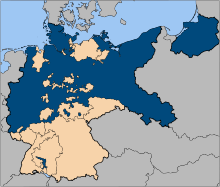
Back ولاية بروسيا الحرة Arabic Estáu Llibre de Prusia AST Вольная дзяржава Прусія Byelorussian Свободна държава Прусия Bulgarian Stad dieub Prusia Breton Estat Lliure de Prússia Catalan Svobodný stát Prusko Czech Fristaten Preussen Danish Freistaat Preußen German Ελεύθερο Κράτος της Πρωσίας Greek
| Free State of Prussia Freistaat Preußen (German) | |||||||||||||||
|---|---|---|---|---|---|---|---|---|---|---|---|---|---|---|---|
| State of the Weimar Republic and Nazi Germany | |||||||||||||||
| 1918–1947 | |||||||||||||||
 The Free State of Prussia within the Weimar Republic in 1925 | |||||||||||||||
| Anthem | |||||||||||||||
| Freistaat Preußen Marsch "Free State of Prussia March" (1922–1935) | |||||||||||||||
| Capital | Berlin | ||||||||||||||
| Area | |||||||||||||||
• 1925[1] | 292,695.36 km2 (113,010.31 sq mi) | ||||||||||||||
| Population | |||||||||||||||
• 1925[1] | 38,175,986 | ||||||||||||||
| Government | |||||||||||||||
| • Type | Republic | ||||||||||||||
| • Motto | Gott mit uns "God with us" | ||||||||||||||
| Minister President | |||||||||||||||
• 1918 (first) | Friedrich Ebert | ||||||||||||||
• 1933–1945 (last) | Hermann Göring | ||||||||||||||
| Reichsstatthalter | |||||||||||||||
• 1933–1935 | Adolf Hitler | ||||||||||||||
• 1935–1945 | Hermann Göring | ||||||||||||||
| Legislature | State Parliament | ||||||||||||||
• Upper Chamber | State Council | ||||||||||||||
• Lower Chamber | House of Representatives | ||||||||||||||
| Historical era | Interwar • World War II | ||||||||||||||
| 9 November 1918 | |||||||||||||||
| 30 November 1920 | |||||||||||||||
| 20 July 1932 | |||||||||||||||
• Nazi seizure of power | 30 January 1933 | ||||||||||||||
| 25 February 1947 | |||||||||||||||
| |||||||||||||||
| Today part of | |||||||||||||||
The Free State of Prussia (German: Freistaat Preußen, pronounced [ˌfʁaɪ̯ʃtaːt ˈpʁɔɪ̯sn̩] ⓘ) was one of the constituent states of Germany from 1918 to 1947. The successor to the Kingdom of Prussia after the defeat of the German Empire in World War I, it continued to be the dominant state in Germany during the Weimar Republic, as it had been during the empire, even though most of Germany's post-war territorial losses in Europe had come from its lands. It was home to the federal capital Berlin and had 62% of Germany's territory and 61% of its population. Prussia changed from the authoritarian state it had been in the past and became a parliamentary democracy under its 1920 constitution. During the Weimar period it was governed almost entirely by pro-democratic parties and proved more politically stable than the Republic itself. With only brief interruptions, the Social Democratic Party (SPD) provided the Minister President. Its Ministers of the Interior, also from the SPD, pushed republican reform of the administration and police, with the result that Prussia was considered a bulwark of democracy within the Weimar Republic.[2]
As a result of the Prussian coup d'état instigated by Reich Chancellor Franz von Papen in 1932, the Free State was subordinated to the Reich government and deprived of its independence. Prussia had thus de facto ceased to exist before the Nazi Party seized power in 1933, even though a Prussian government under Hermann Göring continued to function formally until 1945. After the end of the Second World War, by decree of the Allied Control Council, the de jure abolition of Prussia occurred on 25 February 1947.
© MMXXIII Rich X Search. We shall prevail. All rights reserved. Rich X Search
